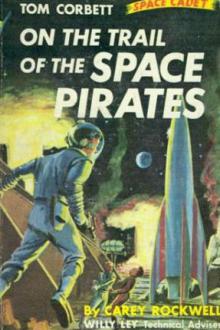Triplanetary E. E. Smith (jenna bush book club .txt) 📖

- Author: E. E. Smith
Book online «Triplanetary E. E. Smith (jenna bush book club .txt) 📖». Author E. E. Smith
Projector at the ready, the Officer of the Day followed Cleve into the Holy of Holies. There the grizzled four-striper touched the golden meteor lightly, then drove his piercing gaze deep into the unflinching eyes of the younger man. But that captain had won his high rank neither by accident nor by “pull”—he understood at once.
“It must be an emergency,” he growled, half-audibly, still staring at his lowly Q.M. clerk, “to make Samms uncover this way.” He turned and curtly dismissed the wondering O.D. Then: “All right! Out with it!”
“Serious enough so that every one of us afloat has just received orders to reveal himself to his commanding officer and to anyone else, if necessary to reach that officer at once—orders never before issued. The enemy have been located. They have built a base, and have ships better than our best. Base and ships cannot be seen or detected by any ether wave. However, the Service has been experimenting for years with a new type of communicator beam; and, while pretty crude yet, it was given to us when the Dione went out without leaving a trace. One of our men was in the Hyperion, managed to stay alive, and has been sending data. I am instructed to attach my new phone set to one of the universal plates in your conning room, and to see what I can find.”
“Go to it!” The captain waved his hand and the operative bent to his task.
“Commanders of all vessels of the Fleet!” The Headquarters speaker, receiver sealed upon the wavelength of the Admiral of the Fleet, broke the long silence. “All vessels in sectors L to R, inclusive, will interlock location signals. Some of you have received, or will receive shortly, certain communications from sources which need not be mentioned. Those commanders will at once send out red K4 screens. Vessels so marked will act as temporary flagships. Unmarked vessels will proceed at maximum to the nearest flagship, grouping about it in the regulation squadron cone in order of arrival. Squadrons most distant from objective point designated by flagship observers will proceed toward it at maximum; squadrons nearest it will decelerate or reverse velocity—that point must not be approached until full Fleet formation has been accomplished. Heavy and light cruisers of all other sectors inside the orbit of Mars. …” The orders went on, directing the mobilization of the stupendous forces of the League, so that they would be in readiness in the highly improbable event of the failure of the massed power of seven sectors to reduce the pirate base.
In those seven sectors perhaps a dozen vessels threw out enormous spherical screens of intense red light, and as they did so their tracer points upon all the interlocked lookout plates also became ringed about with red. Toward those crimson markers the pilots of the unmarked vessels directed their courses at their utmost power; and while the white lights upon the lookout plates moved slowly toward and clustered about the red ones the ultra-instruments of the Service operatives were probing into space, sweeping the neighborhood of the computed position of the pirate’s stronghold.
But the object sought was so far away that the small spy-ray sets of the Service men, intended as they were for close range work, were unable to make contact with the invisible planetoid for which they were seeking. In the captain’s sanctum of the Chicago, the operative studied his plate for only a minute or two, then shut off his power and fell into a brown study, from which he was rudely aroused.
“Aren’t you even going to try to find them?” demanded the captain.
“No,” Cleve returned shortly. “No use—not half enough power or control. I’m trying to think … maybe … say, Captain, will you please have the Chief Electrician and a couple of radio men come in here?”
They came, and for hours, while the other ultra-wave men searched the apparently empty ether with their ineffective beams, the three technical experts and the erstwhile Quartermaster’s clerk labored upon a huge and complex ultra-wave projector—the three blindly and with doubtful questions; the one with sure knowledge at least of what he was trying to do. Finally the thing was done, the crude, but efficient graduated circles were set, and the tubes glowed redly as their massed output drove into a tight beam of ultra-vibration.
“There it is, sir,” Cleve reported, after some ten minutes of manipulation, and the vast structure of the miniature world flashed into being upon his plate. “You may notify the fleet—coordinates H 11.62, RA 124–31–16, and Dx about 173.2.”
The report made and the assistants out of the room, the captain turned to the observer and saluted gravely.
“We have always known, sir, that the Service had men; but I had no idea that any one man could possibly do, on the spur of the moment, what you have just done—unless that man happened to be Lyman Cleveland.”
“Oh, it doesn’t. …” the observer began, but broke off, muttering unintelligibly at intervals; then swung the visiray beam toward the Earth. Soon a face appeared upon the plate; the keen, but careworn face of Virgil Samms!
“Hello, Lyman,” his voice came clearly from the speaker, and the Captain gasped—his ultra-wave observer and sometime clerk was Lyman Cleveland himself, probably the greatest living expert in beam transmission! “I knew that you’d do something, if it could be done. How about it—can the others install similar sets on their ships? I’m betting that they can’t.”
“Probably not,” Cleveland frowned in thought. “This is a patchwork affair, made of gunny sacks and haywire. I’m holding it together by main strength and awkwardness, and even at that, it’s apt to go to pieces





Comments (0)